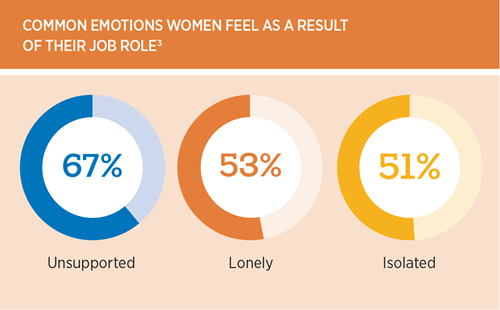
More than 50 years ago, a Beatles song lyric suggested that listeners "look at all the lonely people." And now, the US Surgeon General is using his platform to deliver a more urgent message about the need for action. Loneliness and isolation are epidemic — about 1 in 2 adults have felt the effects in recent years.1 In fact, since 2003, Americans have not only experienced an increase in isolation, but also a decrease in companionship and social engagement.2
Work is contributing to loneliness. That's especially true for women who achieve increasing professional success, whereas men at senior levels are significantly more likely to say career progression decreased their loneliness or isolation. Nearly 70% of women feel unsupported, 53% feel lonely, and 51% feel isolated because of their job.3 For those in leadership roles, this state of distress or discomfort is often more acute — particularly among women of color.
Effects of widespread loneliness on all facets of wellbeing
Loneliness is often difficult to describe and diagnose. It's a wholly subjective experience, but simply put, it describes a feeling of inadequate social connections that can occur even in the presence of others. Conversely, people may not feel alone when they're by themselves. Feelings of loneliness have more to do with the quality than the quantity of a person's social relationships. While loneliness and depression differ, they're interlinked.

Prolonged feelings of isolation are more detrimental to wellbeing than people might think. In fact, lacking social connection can be as dangerous as smoking up to 15 cigarettes a day. Health risks of loneliness include cardiovascular disease, dementia, stroke, anxiety and premature death. At work, employees may be less engaged, which could diminish their performance and productivity.1
Women in leadership roles frequently respond to loneliness with negative coping behaviors such as alcohol or drug use, overexercising or overspending.3 The consequence of these choices is reduced social connectedness that contributes to emotional distress and more loneliness.
Helping to ease, if not cure, loneliness couldn't be more important for employees and organizations. Emotional, physical, financial and career wellbeing are interconnected. Positive or negative developments in one dimension tend to improve or diminish the others, creating circular patterns that are hard to disrupt.
Considering, measuring and gradually addressing loneliness
If employers are well attuned to their workplace culture, they may already be familiar with loneliness and its repercussions, at least to some extent. Even with growing awareness, mitigating loneliness and its effects on employee wellbeing and productivity will be an ongoing pursuit — one that's necessary for optimizing individual and organizational performance. So far, just 10% of employers have addressed loneliness in the workplace, and only 3% have measured its prevalence.4
The main reason for hesitation is uncertainty about the scope of loneliness and how to approach this issue. However, a better understanding of these unknowns may prompt employers to act. By partnering with qualified vendors, they can determine solutions that offer the best potential for their own organization and also discover emerging best practices. Enhancing social connectedness is a strategic priority for 49% of employers, and by 2025 that number may grow to 70%.4
Loneliness is not a female or a male issue. It's a universal challenge. However, highlighting the loneliness of women may provide the visibility and interest needed for leadership to consider all employees in conversations about this topic. Acting to lower attrition should be a key discussion point. Nearly 53% of women have recently declined a job or a promotion, quit or stopped working altogether because of the negative impact on their personal life.3
Compassionate leadership as a learning process
The competencies that leaders and managers need to be successful are different from just three years ago. Currently, only 21% of employers say their managers are internally viewed as supportive.4 This finding is clearly a sign of extensive skill gaps, and a pressing need to equip employees at all levels to work effectively in today's environment. Interestingly, while female leaders report higher levels of loneliness at work than their male counterparts, they also rank more highly at providing emotional support, checking in on overall wellbeing and taking action to help manage burnout.5
Female leadership can increase team engagement as it helps to decrease loneliness. The estimated savings impact of female management styles on organizations, before the cost of replacing a disengaged employee, is $1.43 million for every 1,000 employees.5 Women leaders also do more to support employee wellbeing and foster diversity, equity and inclusion (DEI).
Rewarding and formally recognizing their contributions can substantially influence higher satisfaction and retention levels.
Although research suggests that women may innately lead with more compassion, all leaders can learn a sympathetic orientation.5 Taking time to connect with direct reports to check in on workload and other challenges is especially important because it builds relationships. Regular, positive interaction is a simple and inexpensive tool for reducing or preventing loneliness. Training, peer coaching and advisory circles also help to improve understanding and guide more inclusive approaches.



